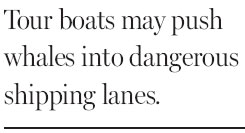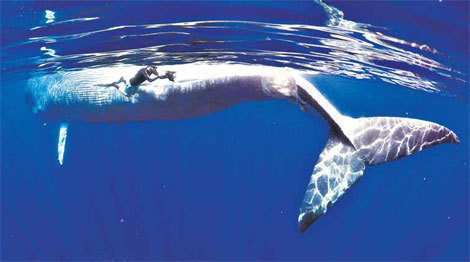Ships pose a threat to Sri Lanka's whales
Updated: 2012-07-15 07:53
By Erik Olsen(The New York Times)
|
|||||||
|
A propeller was blamed for nearly severing the tail of a blue whale found dead off Sri Lanka. It was the sixth recorded whale death of the year. Mazdak Radjainia |
MIRISSA, Sri Lanka - In early April, whale watchers off this country's southern coast were greeted by a disturbing sight: the lifeless body of an 18-meter-long blue whale floating in the water about 20 kilometers offshore.
The body was swelling rapidly, and suckerfish swarmed across its skin. Even more unsettling was the condition of its tail, which had been nearly severed from the body.
"It was very obviously from a ship's propeller," said Mazdak Radjainia, a structural biologist and underwater photographer from the University of Auckland in New Zealand, who happened upon the whale. "It must have been a really cruel death, because it was such a massive injury."
Researchers say ship strikes are a leading cause of death among whales around the globe. The problem is particularly troublesome here in Sri Lanka, where a largely unstudied population of blue whales, possibly numbering in the thousands, has come under increasing pressure from commercial shipping and from a boom in unregulated whale-watching boats.
Scientists do not know for sure whether ship strikes are on the rise. But the whale's death in April was the sixth of the year, according to news reports. In one grisly encounter in March, a blue whale was found draped over the bow of a container vessel in the harbor in the capital, Colombo, 145 kilometers north of this beach resort. Last year, some 20 whale carcasses (not all of them blue whales) were seen around the island, according to Arjan Rajasuriya, a research officer with the National Aquatic Resources Research and Development Agency in Colombo. It is not known how many of the deaths resulted from ship strikes.
"These strikes likely represent only a portion of the likely true mortality," said John Calambokidis, a whale researcher in Olympia, Washington, who documents ship strikes off the West Coast of the United States. Because blue whales often sink soon after they are struck, most such deaths go unrecorded, and Dr. Calambokidis says the true number "could be 10 or 20 times" the number seen.
Twenty-four kilometers off the southern coast of Sri Lanka is one of the world's busiest shipping lanes, and whales are known to swim regularly inside them. But some scientists believe that the increase in whale watching could be forcing whales to seek food farther out, pushing them into the big ships' path.
"I'm afraid the whales are being harassed by the whale-watching boats and that this could affect their movement," said Asha de Vos, a whale researcher here.
The threat to the whales has some researchers scrambling to find a way to protect them.

"Having these whales right off the coast is pretty amazing," said Ari S. Friedlaender, a research scientist at the Duke University Marine Laboratory in Beaufort, North Carolina. "We know so little about blue whales in general that any place that you have easy access to animals like this, your learning curve is going to be exponential."
In 2009, Sri Lanka ended a 25-year civil war that largely kept researchers away. Several general surveys in the 1970s revealed that there were whales here, but it was not until the 1990s that interest started to grow. Researchers were particularly drawn by the whales' tendency to stay here year round; other blue whale populations are known to migrate vast distances.
Three years ago, Ms. de Vos started the Sri Lankan Blue Whale Project, a long-term research program that she hopes will stop the killing and raise awareness of the whales here. For the last three years, she has been photographing the whales and using scientific instruments to better understand their feeding behaviors.
"Clearly, there's something down there that's keeping them around. But we need to know where it is and how much," she said.
In March, Ms. de Vos was helped by researchers from the Duke University Marine Lab who brought along an electronic echo sounder, which uses sound waves to measure the density of prey in the water. For 10 days, she and the team crisscrossed the water, taking measurements and finding spots thick with krill. The data collected will help scientists better understand the whales' feeding - and, she hopes, persuade the government to shift the shipping lanes farther out to sea.
Ms. de Vos has received some financial support from the University of Western Australia, where she is completing a doctorate in oceanography. "Her work is really setting the stage for further research on these animals," said Dr. Friedlaender, who hopes to visit the region next year.
Ms. de Vos notes there is a push to increase tourism, and whale watching is a critical part of the government's development strategy. While the effort may bring economic development to this poor country, Ms. de Vos is concerned.
"Right now, whale-watching boats are driving helter-skelter around the animals," she said.
In other countries with established whale-watching industries, laws prohibit getting close to the animals. Ms. de Vos would like to see similar regulations here.
"In this new era of peace, the blue whale is very fast becoming the symbol of our country," she said. "It would be very sad to harm these animals because of our foolishness."
The New York Times
(China Daily 07/15/2012 page11)
